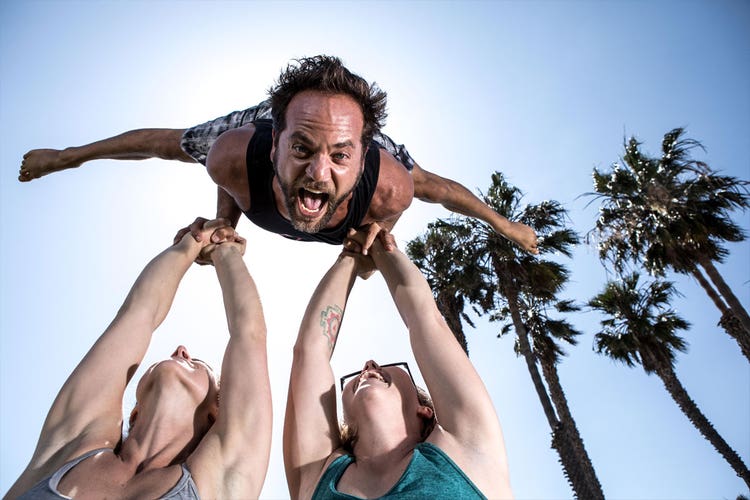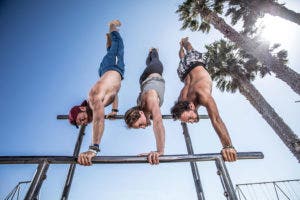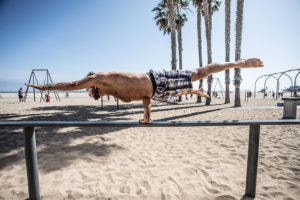Meet the Co-Founder of AcroYoga

AcroYogi and chief visionary, Jason Nemer, shares how this practice is connecting the world one yogi at a time.
Across the Northern Hemisphere, summer invites concerts in the park, street fairs and cultural festivals of every kind. These events are amazing for the culture, cuisine and community they offer, and are the chance to find community in a new way. As an admitted flow junkie, I love to frequent yoga and music festivals for the sense of adventure that they offer and the newness that they bring to my life—especially the chance to experience a new yoga practice with a new teacher. I always leave inspired and armed with something new to bring back to my practice and, as a teacher, something new to share with my students.
My first encounter with AcroYoga was in Central Park with a group of yogi friends, but I officially had my first chance to fly at a yoga festival in New York City. I loved the art and the physicality of it. The practice transforms yoga from a solo practice to a community one, and combines acrobatics, yoga and Thai massage—all of which have an ancient heritage.
Since then, it has been fascinating to watch this style of practice grow and take root across the globe. Recently, 24Life had the opportunity to connect with Jason Nemer, the co-founder of AcroYoga. Nemer is the Chief Visionary Officer whose vision leads the development of the practice, and is responsible for the certification of teachers at all levels. The practice was founded in 2003 in Northern California by Nemer, a yoga teacher and acrobat who represented the United States at age 16 in the 1991 World Championships of Sports Acrobatics in Beijing, and Jenny Sauer-Klein, a yoga and circus-arts teacher. When right side up, Nemer enjoys making music, cooking and beach-ocean time. He is a masterful coach with a natural gift for bringing people together to move them and to help them be moved.
Here, on International Yoga Day and the first official day of summer, Nemer shares his philosophy and vision for AcroYoga.
24Life: What is AcroYoga?
Jason Nemer (JN): AcroYoga came from the desire to have people laugh more, have people connect more, have people do things they never thought they could do. AcroYoga blends three infinitely profound traditions: yoga, acrobatics and healing arts. The premise is that you can find more potential when two [or] three people work together to lift each other up, and that’s the energetics. The mission of the practice is to find ways that—in a community—we can become more than we are as individuals. By combining acrobatics, yoga and healing arts, the practice of AcroYoga has built a community of active teachers and practitioners all over the world.
24Life: What are the elements of AcroYoga?
JN: Usually, an AcroYoga session starts with an opening circle that enables the participants to breathe and move together. Then, there are warm up sessions involving a sequence of yoga poses. Next is the partner session [which] includes stretches. Stretching is followed by inversions and supported flying. The practice completes with Thai massage as a healing experience.
The essence of AcroYoga is about being completely present and attentive with another person in the flow of movement. This requires trust with a partner, and a commitment to stay open to curiosity, freedom and play. Besides the solo practice, there are at least three people involved in each movement—a base on the bottom, a flyer on top and a spotter to prevent any falls—these are the critical elements AcroYogis rely on to execute a pose. The flyer puts [his or her] faith in the base in order to rise into the posture. The base must be solid, steady and confident—and [he or she] must trust the flyer. The spotter is completely focused to keep them safe.
24Life: How did you get started in this practice?
JN: An AcroYogi is somebody that blends acrobatics, yoga and healing arts. I’ve been doing this now for 13 years. My mom was my first yoga teacher; she taught me transcendental meditation when I was four, and she would have us do shoulder stands when commercials came on. I started acrobatics when I was 12—30 years ago. My little brother was doing gymnastics, and I decided to go watch him. And after watching one session, I was like, “That’s never going to happen again. That looks super fun. I want to try it.” I started going and doing the classes.
About three months into my gymnastics, there were these guys doing acrobatics. And I immediately was drawn to it. I saw it and I fell in love with it. What I saw was somebody holding another person in a handstand. And of course, I went straight to the flyer and looked at the little girl on top thinking, “Wow. She’s so amazing.” I didn’t think about how hard the base was working to do it, but it captured me. What it captured was this ability for two people to drop into a singular moment of connection. I just went straight up to them and asked them if they would teach me, and they did, and I never stopped. Since then, I’ve had the fortune of meeting a lot of amazing people that taught me how to move in very dynamic and fun ways, and I’ve been dedicating my life to teaching other people how to move in dynamic fun ways. I help people realize that they can do more than they think they can. That’s kind of the driving force. And there are a lot of people that when they get touched by the practice, they want to share that with others as a gift.

24Life: How else does AcroYoga impact those who participate?
JN: AcroYoga impacts you on multiple levels. Touch is something that is needed for humans to be healthy and happy. What I see is what I believe. I believe that we’re born with all the wisdom we ever need in our life. And basically, life is about uncovering that wisdom. And the body is the holder of the wisdom, of the trauma, and everything in between. Movement teachers help individuals connect to the wisdom that’s in their body. And as a teacher does that, that wisdom stays with the person. And as thousands of people are moving and connecting to this wisdom that they’re born with, they get to leverage that in their lives. It’s much less about what you do in a 90-minute practice, and much more about the wisdom that you uncover during that practice that then affects your life.
24Life: There seems to be a renaissance around health, fitness and wellness in the industry, and we have swung back to recognize whole movement similar to the movement towards whole food.
JN: The renaissance movement is taking these very traditional, beautiful movements but not having that be the end—[but] having that being the beginning. And the end is there is no end. Really, all of these practices will just lead us to this fountain of creativity, and how you move, and how you let fitness and movement be the same thing. People are way more capable than they think. It doesn’t have to be that fitness is something we do one hour a day. It’s something that develops your potential in how you know how to move and how you know how to play with the environment. There’s not the separation.
24Life: You travel often to many cultures; how do you stay true to your practice?
JN: I actually just wrote a little Instagram post recently about this saying that my favorite breakfast is asana. I love to get up and just do my stretches, do my practices. Ideally, when I have it, I take a bath. I drink my tea in the bath, oftentimes. I do my meditation. I do a little bit of my stretching practice. But all that can be about an hour, and when I do that, I’m set up so well for my day.
From there, some other techniques that have really helped me is I surround myself with amazing people that I love dearly and that they love me. And it’s not that I don’t find difficult people or challenging situations, but I’ve basically been traveling the world now for a long time, finding amazing humans, and we support each other. I can land in Germany, and drop in with some dear friends, and have really deep conversations about life, and love, and movement and all these things. So, those are some aspects that, I think, keep me very healthy. I’m also very passionate about what I do, and I get fed by what I do. When I see somebody realize that they have more potential than they thought, there’s not much else that I need for my day to feel full. When I know there are people around me that are happy, and moving and being connected to their joy, these are the fountains that keep feeding me.
24Life: Is this practice for everyone—all ages, levels of conditioning and various level of yoga knowledge?
JN: There are a lot of ideas about movement, and aging and things that are and aren’t appropriate. There’s some validity behind it. Gymnastics and acrobatics, they’re actually two very different sports. You don’t see 80 and 90-year-old gymnasts; it doesn’t happen. It’s high impact. Even if you do that sport correctly, it’s hard on the body. Acrobatics, on the other hand, is not that. I’ve seen and trained with people that are 60, 70, 80, 90. It’s not strange when I see older people doing amazing things. Your mind is the portal that either opens or closes your body’s potential. If you think you can’t do it, you’ll be right. If you think you can do it, you’ll be right. And then you have to listen to what your body tells you after you get done with that workout. Was that affirming to my life, or did I push it too much? And what can I do now to restore and recover my health and my balance and make a better decision when I go back to that practice? It doesn’t matter if you’re old or young, it’s the same ability to listen to where you are in your practice, to challenge your practice and to keep moving.
24Life: What advice do you have for someone learning the practice?
JN: My mom would come watch for the first several months. And she would joke that she’s going to bring popcorn and just laugh because we’re falling all over. I never really got hurt, but [there was] a lot of comedy involved in the first three months.
Be sure to practice around the right people to create the right environment. Know you are going to fall, but just keep showing up and know that a passion will grow. When you dedicate to a movement, like I’ve been doing the splits for 30 years, and I’ve changed my approach and I’ve changed my flexibility and I’ve changed a lot of things, but it’s the same pose. I keep going deeper into the same well to learn more about myself through that one pose.
It’s the capacity of listening to your heart and being disciplined in how you understand how to move this amazing vehicle that’s got so much potential.
24Life: How does AcroYoga impact culture?
JN: There is a global potential that’s being realized through movement. As I travel around the world because of a lot of these movement trends—whether it be yoga, CrossFit, AcroYoga—it’s breaking down the barriers of culture, that certain people wouldn’t necessarily move in these ways, but it is something that is uniting humanity. Because when people move, they feel good. This is a commonality. You don’t need to speak the same language to understand the same body feeling when you get done with a movement practice. I see more and more that there are more people doing the similar practices that are bringing things together.
I have a lot of passion to bring peace to the Middle East. What a great hippie thing to say from a California kid, right? I don’t understand anywhere near enough to go in there and say, “I’m going to bring peace to the Middle East.” But I can bring tools to people in the Middle East that know a lot more than I do about what they’re actually struggling with, so that gave me a lot of comfort and freedom in knowing that it’s not my responsibility to change the world in the way that I want it to be changed. It’s my opportunity to give people tools to connect to each other, to listen to each other, to heal with each other. And then from there, everyone’s individually empowered to take this practice in the direction that affirms who they are and who their community is. Touch is something that is an essential quality to bringing people together and to really understanding what this practice of yoga can bring, which is unity and togetherness.

24Life: What is next for you and for AcroYoga?
JN: AcroYoga is breaking into the mainstream, and big organizations that see and experience the value of this practice are going to help me get it to more people. I want to get this practice to a billion people before I leave my body. I’ve definitely got it to a million, so there’s a couple of zeros in vibrational escrow, you might say.
And where I see fitness going in general, it’s the same where I see yoga has gone for me in my life. To me, in the beginning, yoga was this 90-minute practice. But then it became something that spread across everything that I do, and I think fitness can be the same thing. Fitness to many people is going in and doing your workout. But you can constantly find ways to blur the lines of, “Am I going out for a coffee or am I going to run in, parkour off the wall and jump down the slide because that’s what I want to do because it’s fun, and it inspires other people to do that?” Right now, it’s not so culturally accepted to do parkour and AcroYoga everywhere and all the time. But that is what I think will happen over time, as people will take the very basic movements and make them more interesting as they expand their playground.
And fitness can be something that is as big as you’re willing to play with it. I remember the first time I saw this move called Ninja Star—it blew my mind. I had never imagined humans moving in that way, and I’ve seen tons of acrobatics all over the world. I’d never seen this type of movement before, so there was this creative potential that was generated from the community. I definitely believe at this point it’s exponential and infinite what we can do with this practice. Because even though we’re fixed in our bodies, the potential of two and three people and what they can do when they get together and they have that creative space, it’s amazing. So, that’s the vision that I have.
Photo credit: Tom Casey, box24studio.com